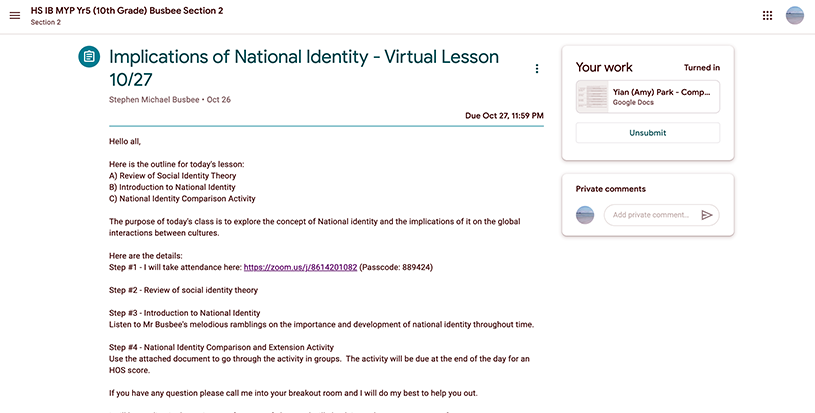With the continuation of the COVID-19 pandemic, online courses are exploding in popularity, and most schools are using apps such as Zoom and Google Hangouts to learn and communicate with teachers. As a result, virtual learning has helped a large number of people stay safe from the virus and allowed students to work in a comfortable environment. However, being free to relax at home and studying in an environment more comfortable than usual has compelled a number of students to lose focus and even skip classes. Therefore, should virtual learning continue even after the COVID-19 pandemic is over? To find different perspectives on this controversial issue, I interviewed my humanities teacher, Mr. Busbee, who is very interested in this topic.

“Although I do think there are both positive and negative aspects in both virtual and in-class learning, I personally think in-class learning is much more effective,” said Mr. Busbee. First of all, he strongly believes that in-class learning is better for students to focus and engage more. He went on, “I think it is harder for students to speak up in virtual learning with their microphones muted,” while emphasizing the fact that he rarely gets questions after doing virtual classes. While there were several students that came to him and asked questions during study hall after in-class learning, ever since changing to virtual learning, study hall sessions have become free time for him.
In addition, he spoke about how people were looking down instead of looking at the screen during virtual classes. He guessed that they were using their phones. “I personally understand this because my son once spent more than five hours playing Roblox (type of game) at school, but this is an issue that we seriously need to fix,” he said with a little laughter. He wishes that parents would restrict their children’s use of electronic devices and added that personally he is limiting his son’s game time using an application. He pointed out that this is a method all parents can adopt.

Also, he noticed that this issue is getting more serious with time despite his expectation that students would adjust to this new system. “With virtual learning continuing, I noticed that some students are often late to class and some had completely missed few classes. This worries me a lot,” he added. He stated that most students’ excuses were Wi-Fi problems, laptop problems, and more, which he thought are rather random excuses. Even though he believed the students at first, he started to get mystified when he realized that the same excuses were being repeated.
After a little hesitation, Mr. Busbee also mentioned how teachers have a hard time teaching students and communicating with other teachers as well. “The difficulties of virtual learning are a problem not only for the students but for teachers as well,” he said with a little smile. While discussing with other teachers about upcoming exams, he noticed how a myriad of schedules had to be changed to make the exam suitable for online. Tests had to be pushed back, group activities canceled, and more. “There is a lot more work that teachers have to do for virtual classes, even though I believe in-class learning is much more effective,” he said.
He went on to conclude, “I know that virtual learning is necessary in this pandemic, but I hope virtual learning doesn’t continue after COVID-19.”
In some ways, virtual learning is essential, and there are both pros and cons of in-class learning and virtual learning. One of the benefits is that students save time on transportation and can study in a comfortable environment. However, this new way of learning can also lead to lack of focus and social communication. Therefore, everyone should ask themselves: is virtual learning really a worthy replacement for in-class learning, which has been around for more than 400 years? I believe that the answer is obvious.

Amy Park
Grade 10
Seoul Foreign School

